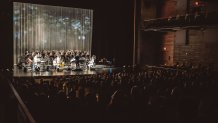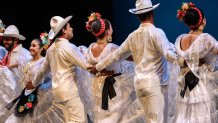Tell a story about a deceased loved one and they live again. That is the central idea behind a collaborative celebration of Día de los Muertos at Arts Mission Oak Cliff in Dallas from Oct. 31 to Nov. 2.
Verdigris Ensemble, Anita N. Martinez Ballet Folklorico, Arttitude and cultural worker and writer Ofelia Faz-Garza of Cascabel Group join forces to commemorate the Mexican holiday that dates to the Aztecs.
Día de los Muertos, or Day of the Dead, originated in ancient Mesoamerica - now Mexico and northern Central America - with Aztecs, Maya, Toltec and other indigenous groups celebrating ancestors. The holiday is colorful and vibrant, blurring the line between sacred and secular, the living and the dead. "It's a celebratory holiday," Sam Brukhman, Verdigris Ensemble's artistic director, said. "It's a beautiful holiday of remembrance and celebration."

Verdigris Ensemble will sing music reflective of the holiday's cultural roots. "It presents opportunities both for scared and secular music because it has been intertwined with the church in recent history, but it stems from a secular culture. It's interesting to see how it has evolved over time," Brukhman said. "It's sacred, it's secular, it's ritualistic, it's celebratory."
Brukhman selected pieces by Latinx/Hispanic composers including Diana Syrse, Ariel Ramirez and Vicente Chavarria. The music features foot percussion and indigenous instruments including a death whistle, an instrument that Aztec warriors carried into battle.
The choir represents the world of the living while dancers from Anita N. Martinez Ballet Folklorico represent the spirit realm. "We're looking at how to try to reflect that thin veil between the living and those who have passed on," Alexandra Hernandez, Anita N. Martinez Ballet Folklorico's program manager and choreographer of this celebration. "When you tell a story about someone who is no longer there and you get really involved in the story, it feels like they are still there. So, what we're trying to play with in the dance aspect is what it is when somebody's spirit is there, to get lost in the movement, to get lost in the music that you forget what the reality is."

Faz-Garza and Jerome Larez, co-founder and board chair of Arttitude, are working with artists to create ofrendas. Ofrendas are three-tiered altars created to honor a deceased loved one. The ofrenda traditionally includes elements of earth, wind, water and fire. Water and salt are placed on the ofrenda to quench the thirst of the dead. Food, representing earth, is nourishment for the spirit's journey. Candles illuminate the spirit's way. Marigolds create path to the spirit's altar. "It's to provide a welcome and a place for them so that there's still a place for them in your home," Faz-Garza said.
Local
The latest news from around North Texas.
Photos, personal belongings and favorite foods individualize the ofrenda. At the celebration, audience members are invited to honor a loved one by purchasing a commemorative marigold. Proceeds from the marigolds sponsor tickets for local families and students to attend Día de los Muertos performances. Patrons may also share a personal item at a communal ofrenda. "You'll be able to see so many different ethnicities and backgrounds that make-up this community. It will be a unique piece of art that changes from night to night," Brukhman said.
Family history is shared during Día de los Muertos. "There's a belief that you don't ever really die until you are forgotten and that's why it is so important to remember," Hernandez said.
Larez learned about his grandmother's brother, a relative he never met, during Dia De Los Muertos. "I've heard so many stories of family members," Larez said. "There's still so much of our history we don't know. That's part of the tradition of passing down our history."
Hernandez recognizes traits of her loved ones in herself. Her family shared stories about her great-grandfather's stubbornness. "Oh, that's where I get it from," Hernandez said with a laugh.
When Faz-Garza's grandfather died, her family made celebrating Día de los Muertos a priority. "I'm passing it on to my children, sharing the stories and it's comforting to them to give them a chance to understand the world around them."
Celebrating ancestors' contributions to family and community is a distinctive element of Día de los Muertos, a stark contrast with America's individualist culture. "We would be nothing without them. We walk in our ancestors' footsteps," Faz-Garza said. "I'm very conscious of who I come from and I'm here because of them."
"That's part of our identity as Latinx people," Larez adds. "Our culture, our tradition, how we celebrate and how we see life and death is very much how we identify."
Larez emphasizes this celebration is for the entire community. "It's about presenting something authentic. If you're not Latinx, you can come in, you can understand and you can experience it with the music, with the dancing and with the art of the ofrendas. There's multiple ways of experiencing where the traditions come from and why we do it," he said. "It's a cultural experience for everyone."
Learn more: https://www.verdigrismusic.org/muertos



